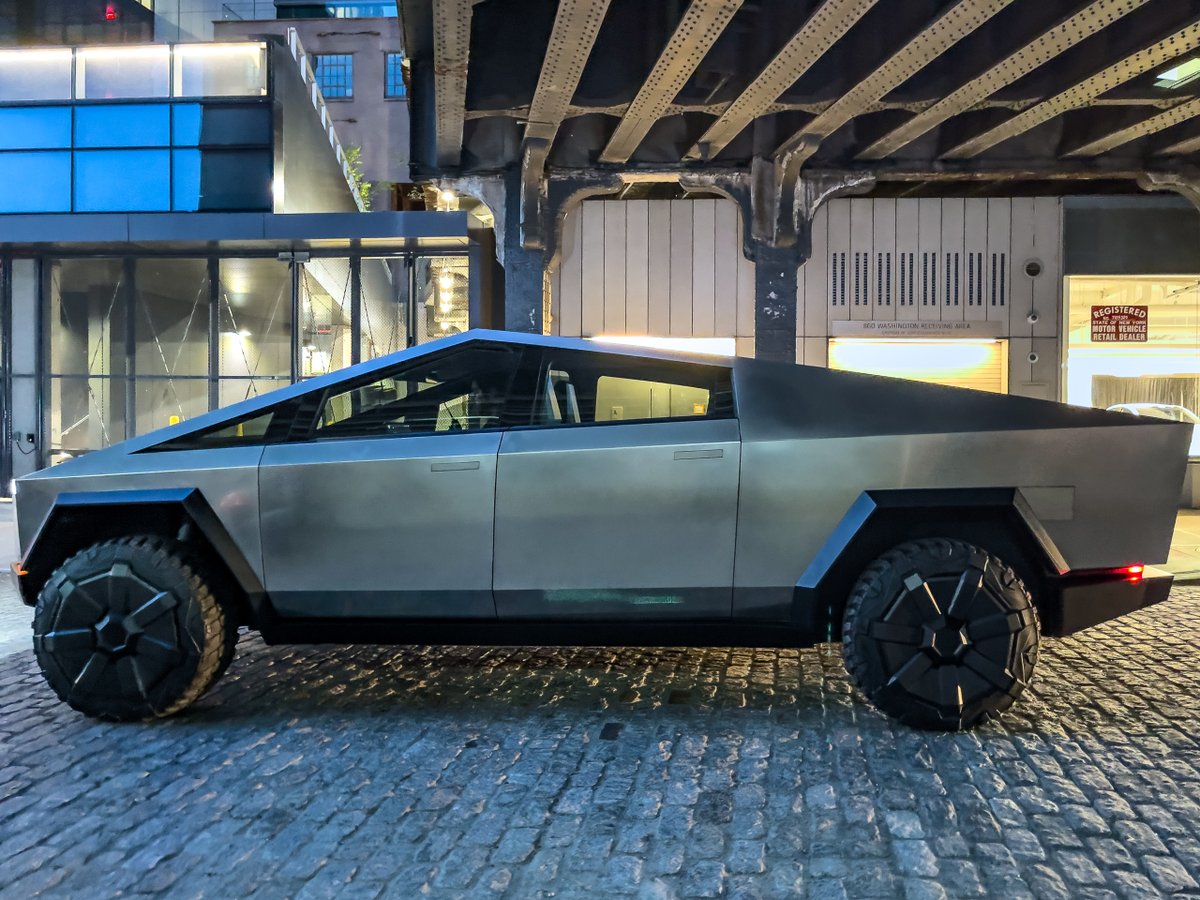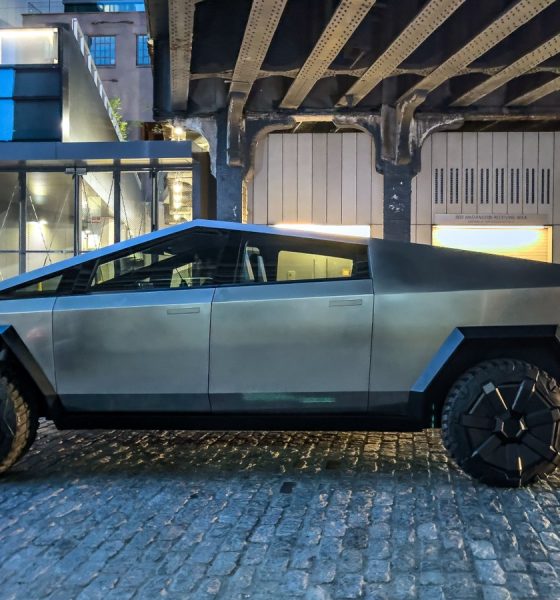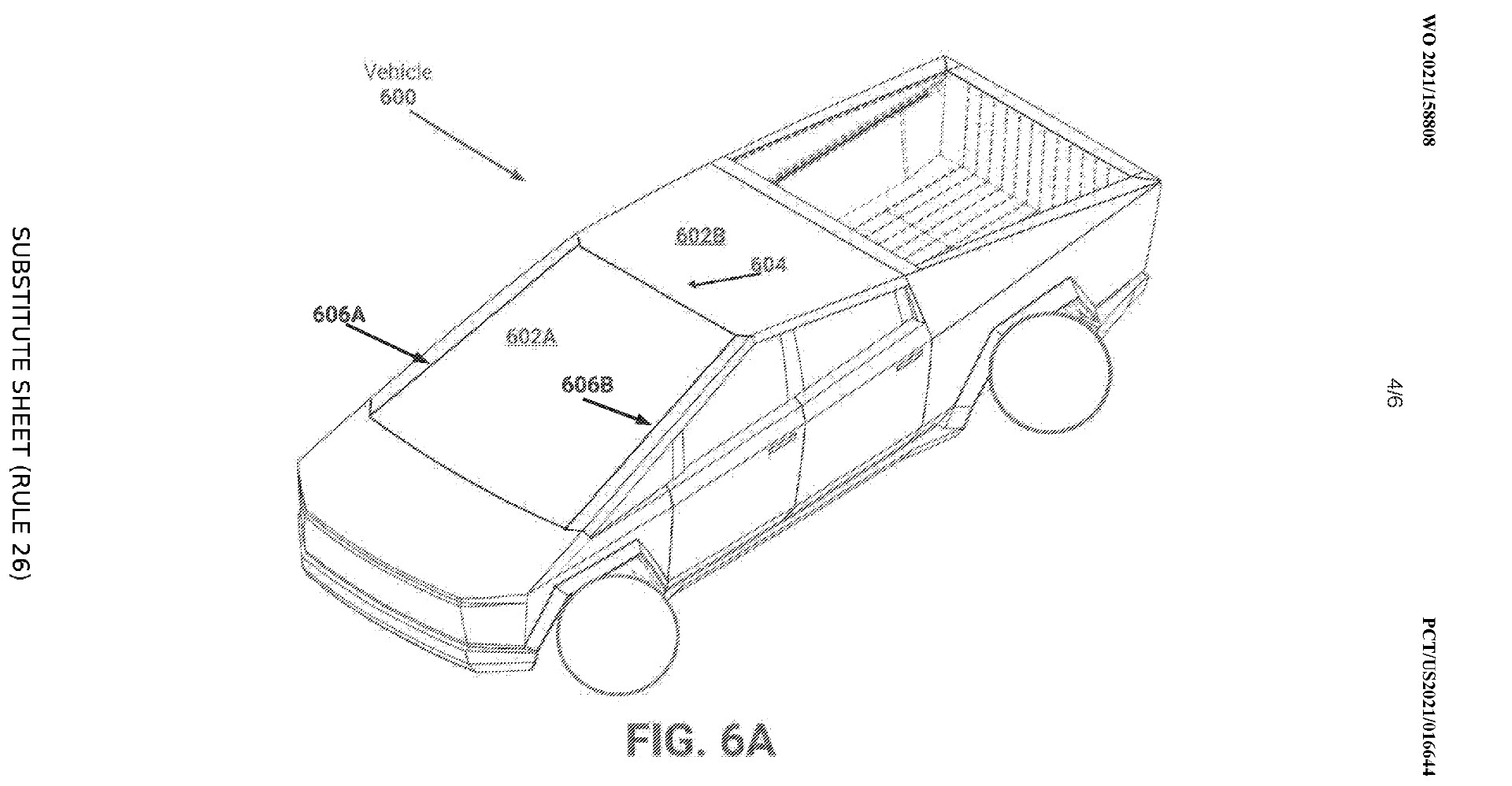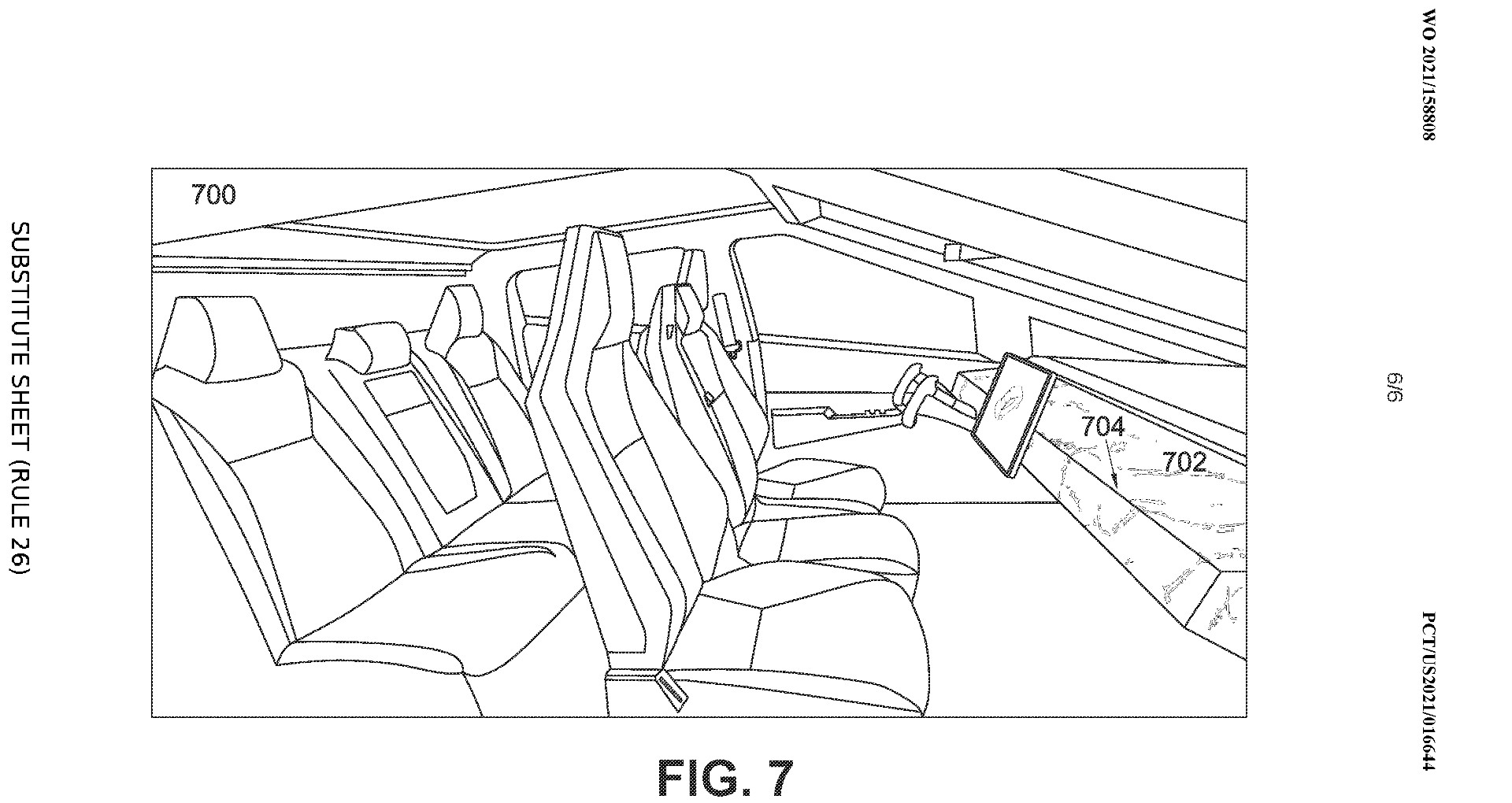

News
Tesla Cybertruck’s updated origami-style windshield and dash teased in patent
Elon Musk has mentioned that the Tesla Cybertruck’s production version would be extremely similar to the all-electric pickup truck’s controversial prototype from 2019. While this may largely be the case, Musk has hinted at some new features that would be included in the production Cybertruck. Apart from updated door handles and rear-wheel steering capabilities, for example, Musk also hinted at “other great things” coming for the vehicle.
A recently published patent application from Tesla has now hinted at a couple more updates that may be coming to the Cybertruck, at least on the design front. The patent, titled “Automotive Glass Structure Having Feature Lines and Related Method of Manufacture,” describes a way to form extremely durable glass structures with aggressive curves and folds. Using such a technique, Tesla stated that it could create components like windshields with very aggressive feature lines that would otherwise not be possible with conventional glass-forming methods.

The patent application’s illustrations showcased how the system would be used in a vehicle such as the Cybertruck. One of the images in the patent featured the far left and right side of the Cybertruck’s windshield having aggressive feature lines that make the all-electric pickup truck even more futuristic and CGI-esque. This is quite different from the windshield used on the prototype Cybertruck, which seemed completely flat.
“The first glass structure 602A may represent a windshield positioned on the vehicle and formed according to the techniques described herein. In some embodiments, the first glass structure 602A may be multi-layer… Thus, the first glass structure 602 A may have feature lines (e.g., facets) 606A-606B. As an example, these feature lines 600A-600B may have radii of curvatures of between 2 mm and 5 cm. In some embodiments, the feature lines 600A-600B may represent an angle of between 45-60 degrees, or 50-75 degrees, and so on.”
Tesla’s unique glass patent application is not limited to the exterior of vehicles. Still using the Cybertruck as an example, Tesla highlighted that its glass-forming patent could also be used to create the all-electric pickup truck’s dashboard, which was made of recycled paper composite materials in the prototype. Tesla’s patent application showed that the Cybertruck’s dashboard could be made of glass instead, giving the vehicle an aesthetically pleasing interior accent. A film layer used with the folded glass would provide the dashboard with additional durability, ensuring that the component does not shatter during impacts.

“Figure 7 illustrates an example of an interior 700 of a vehicle, such as the vehicle 600 described above. The interior 700 includes a glass dash 702 with a feature line 704. As described above, the feature line 704 may have a radius of curvature of between 2mm and 5cm. In some embodiments, the feature line 704 may represent an angle of between 45-60 degrees, or 50-75 degrees, and so on.
“The glass dash 702 may be formed according to the techniques described above. For example, the glass dash 702 may be formed as described in Figure 2. Thus, a single layer of glass may be used and locally heated to form the feature line 704. In some embodiments, a film or layer may be positioned below the glass dash 702. For example, the film or layer may be used to present a visual design and/or may be used to ensure the glass does not shatter (e.g., a safety or security film).”
The Cybertruck’s design has already been finalized, and it remains to be seen if the folded glass components outlined in the patent application would actually make it to the all-electric pickup truck’s production version. Tesla watchers would likely not need to wait for long, however, as the company has noted that the Cybertruck should enter its beta stage by the end of the year, with production starting at Giga Texas next year.
Tesla’s new patent application could be accessed below.
WO2021158808-PAMPH-20210812-5162 by Simon Alvarez on Scribd
Don’t hesitate to contact us with news tips. Just send a message to tips@teslarati.com to give us a heads up.

News
Tesla FSD fleet is nearing 7 billion total miles, including 2.5 billion city miles
As can be seen on Tesla’s official FSD webpage, vehicles equipped with the system have now navigated over 6.99 billion miles.

Tesla’s Full Self-Driving (Supervised) fleet is closing in on almost 7 billion total miles driven, as per data posted by the company on its official FSD webpage.
These figures hint at the massive scale of data fueling Tesla’s rapid FSD improvements, which have been quite notable as of late.
FSD mileage milestones
As can be seen on Tesla’s official FSD webpage, vehicles equipped with the system have now navigated over 6.99 billion miles. Tesla owner and avid FSD tester Whole Mars Catalog also shared a screenshot indicating that from the nearly 7 billion miles traveled by the FSD fleet, more than 2.5 billion miles were driven inside cities.
City miles are particularly valuable for complex urban scenarios like unprotected turns, pedestrian interactions, and traffic lights. This is also the difference-maker for FSD, as only complex solutions, such as Waymo’s self-driving taxis, operate similarly on inner-city streets. And even then, incidents such as the San Francisco blackouts have proven challenging for sensor-rich vehicles like Waymos.
Tesla’s data edge
Tesla has a number of advantages in the autonomous vehicle sector, one of which is the size of its fleet and the number of vehicles training FSD on real-world roads. Tesla’s nearly 7 billion FSD miles then allow the company to roll out updates that make its vehicles behave like they are being driven by experienced drivers, even if they are operating on their own.
So notable are Tesla’s improvements to FSD that NVIDIA Director of Robotics Jim Fan, after experiencing FSD v14, noted that the system is the first AI that passes what he described as a “Physical Turing Test.”
“Despite knowing exactly how robot learning works, I still find it magical watching the steering wheel turn by itself. First it feels surreal, next it becomes routine. Then, like the smartphone, taking it away actively hurts. This is how humanity gets rewired and glued to god-like technologies,” Fan wrote in a post on X.
News
Tesla starts showing how FSD will change lives in Europe
Local officials tested the system on narrow country roads and were impressed by FSD’s smooth, human-like driving, with some calling the service a game-changer for everyday life in areas that are far from urban centers.

Tesla has launched Europe’s first public shuttle service using Full Self-Driving (Supervised) in the rural Eifelkreis Bitburg-Prüm region of Germany, demonstrating how the technology can restore independence and mobility for people who struggle with limited transport options.
Local officials tested the system on narrow country roads and were impressed by FSD’s smooth, human-like driving, with some calling the service a game-changer for everyday life in areas that are far from urban centers.
Officials see real impact on rural residents
Arzfeld Mayor Johannes Kuhl and District Administrator Andreas Kruppert personally tested the Tesla shuttle service. This allowed them to see just how well FSD navigated winding lanes and rural roads confidently. Kruppert said, “Autonomous driving sounds like science fiction to many, but we simply see here that it works totally well in rural regions too.” Kuhl, for his part, also noted that FSD “feels like a very experienced driver.”
The pilot complements the area’s “Citizen Bus” program, which provides on-demand rides for elderly residents who can no longer drive themselves. Tesla Europe shared a video of a demonstration of the service, highlighting how FSD gives people their freedom back, even in places where public transport is not as prevalent.
What the Ministry for Economic Affairs and Transport says
Rhineland-Palatinate’s Minister Daniela Schmitt supported the project, praising the collaboration that made this “first of its kind in Europe” possible. As per the ministry, the rural rollout for the service shows FSD’s potential beyond major cities, and it delivers tangible benefits like grocery runs, doctor visits, and social connections for isolated residents.
“Reliable and flexible mobility is especially vital in rural areas. With the launch of a shuttle service using self-driving vehicles (FSD supervised) by Tesla in the Eifelkreis Bitburg-Prüm, an innovative pilot project is now getting underway that complements local community bus services. It is the first project of its kind in Europe.
“The result is a real gain for rural mobility: greater accessibility, more flexibility and tangible benefits for everyday life. A strong signal for innovation, cooperation and future-oriented mobility beyond urban centers,” the ministry wrote in a LinkedIn post.
News
Tesla China quietly posts Robotaxi-related job listing
Tesla China is currently seeking a Low Voltage Electrical Engineer to work on circuit board design for the company’s autonomous vehicles.

Tesla has posted a new job listing in Shanghai explicitly tied to its Robotaxi program, fueling speculation that the company is preparing to launch its dedicated autonomous ride-hailing service in China.
As noted in the listing, Tesla China is currently seeking a Low Voltage Electrical Engineer to work on circuit board design for the company’s autonomous vehicles.
Robotaxi-specific role
The listing, which was shared on social media platform X by industry watcher @tslaming, suggested that Tesla China is looking to fill the role urgently. The job listing itself specifically mentions that the person hired for the role will be working on the Low Voltage Hardware team, which would design the circuit boards that would serve as the nervous system of the Robotaxi.
Key tasks for the role, as indicated in the job listing, include collaboration with PCB layout, firmware, mechanical, program management, and validation teams, among other responsibilities. The role is based in Shanghai.
China Robotaxi launch
China represents a massive potential market for robotaxis, with its dense urban centers and supportive policies in select cities. Tesla has limited permission to roll out FSD in the country, though despite this, its vehicles have been hailed as among the best in the market when it comes to autonomous features. So far, at least, it appears that China supports Tesla’s FSD and Robotaxi rollout.
This was hinted at in November, when Tesla brought the Cybercab to the 8th China International Import Expo (CIIE) in Shanghai, marking the first time that the autonomous two-seater was brought to the Asia-Pacific region. The vehicle, despite not having a release date in China, received a significant amount of interest among the event’s attendees.








